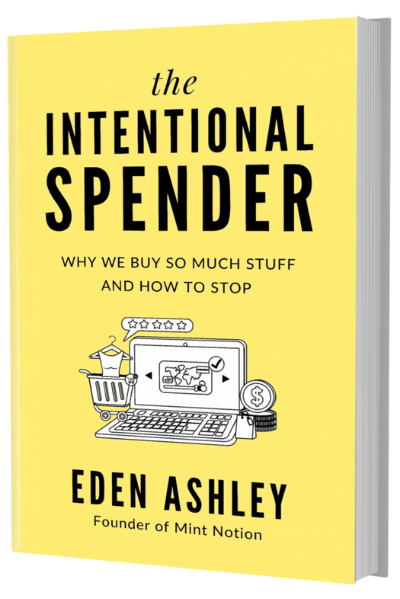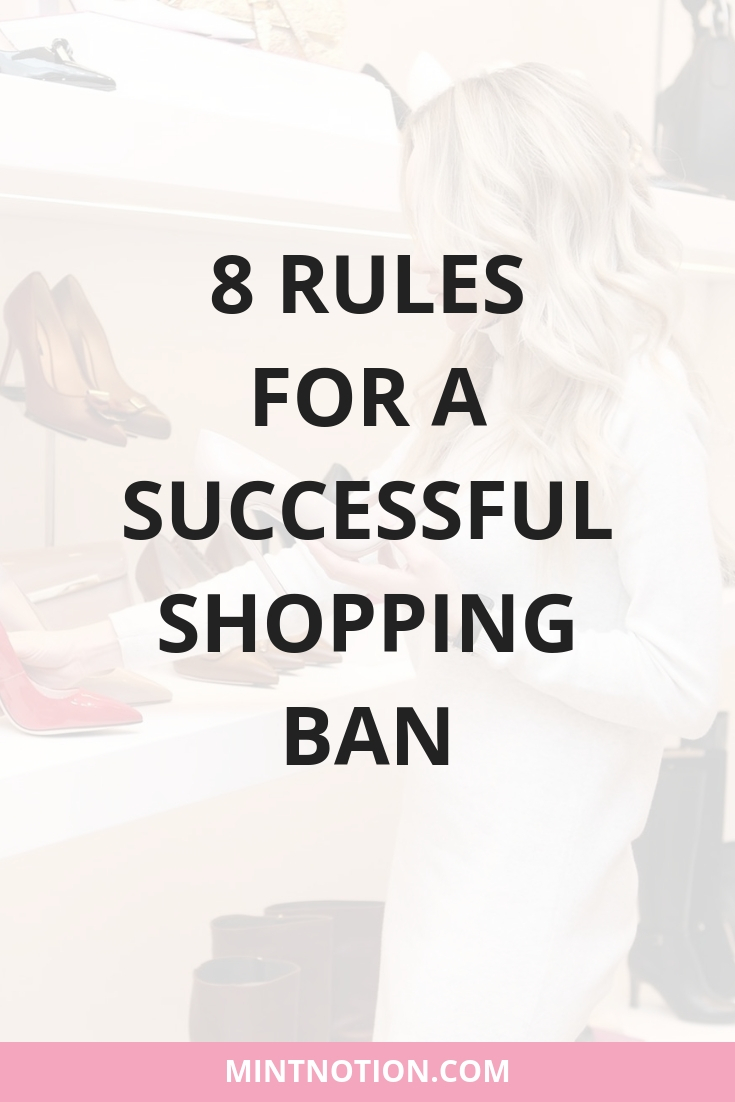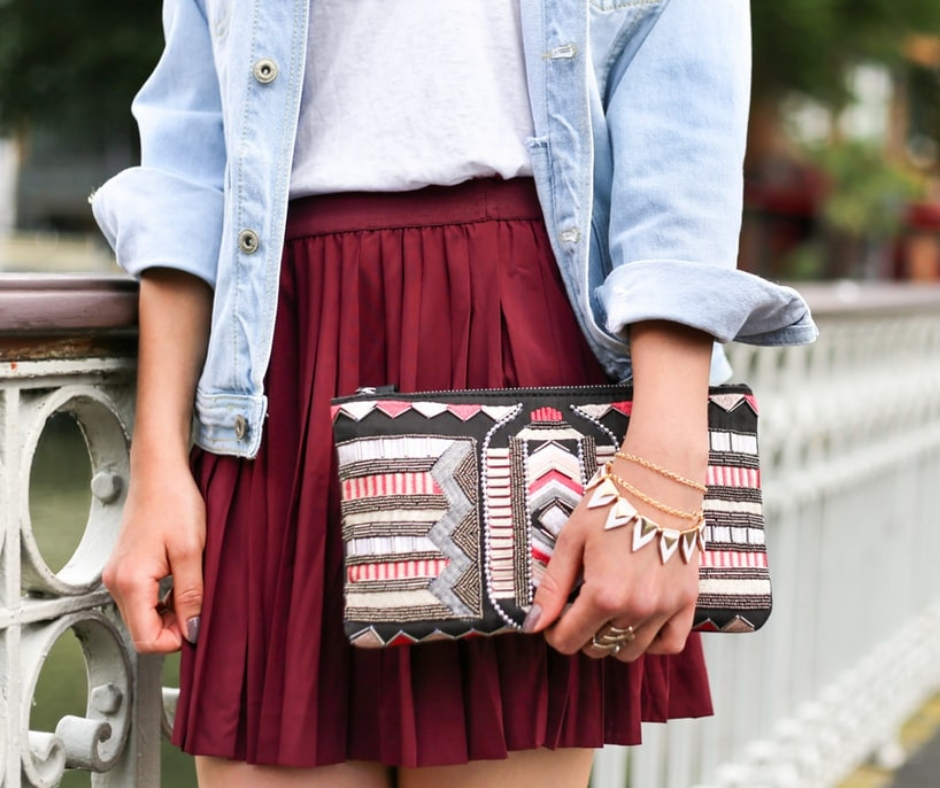Are you interested in learning how to do a shopping ban?
Taking a break from shopping, whether it’s a clothes shopping ban or doing a complete spending freeze, is a popular way to help reset your finances and save money.
Could you go for one month without shopping?
There are many reasons why someone would want to try a shopping hiatus. Perhaps it’s because you’re having trouble saying “no” to impulse purchases. Or maybe you want to save more money because you want to purchase a new home or pay off debt faster.
No matter what the reason is, it’s easy to have a love-hate relationship with shopping. On one hand, it feels good to shop and buy new stuff once in a while. But on the other hand, it’s easy to let our spending habits get out of control if we’re not careful.
Because so many of us enjoy shopping, sometimes it’s difficult to tell when our spending habits have crossed the line and turned into a shopping addiction.
If you’re interested in learning more about how a shopping ban can help you develop better spending habits and save more money, then keep reading!
Related Posts:
- 5 ways to stop overspending on impulse buys
- How to wear everything in your closet
- 3 mistakes people make when doing a shopping hiatus
Table of Contents
What is a shopping ban?
A shopping ban is where you don’t spend any money on certain items for a set period of time, such as a weekend, a week, a month, or a year.
You get to decide which items are on your “no spend” list and which items you have permission to purchase during your ban. Here are a few different ways you may want to impose a shopping ban:
Complete shopping ban: This is where you don’t spend money on ANYTHING for a set period of time. This means not spending money on clothes, dining out, entertainment, and so on. It’s taking a complete break from spending money.
I did a complete shopping ban this past January (except for groceries). This helped me save $10,000 in one month after having a big spend month over Christmas.
Category shopping ban: This is where you choose ONE category in your budget that you want to stop spending money on for a set period of time.
For example, choosing to stop buying any new clothes, shoes or accessories for 30 days or longer. Another popular one is to an ONLINE shopping ban, where you don’t buy anything online for a certain period of time.
I did the no new clothing challenge for an entire year. This helped me save thousands of dollars and learn how to better manage my spending triggers so I could overcome my shopping addiction.
Multiple category shopping ban: This is where you choose at least TWO categories in your budget that you want to stop spending money on for a set period of time. For example, choosing to stop buying clothes and dining out (fast food and restaurants) for 30 days or longer.
What are the benefits of shopping ban?
The purpose of doing a shopping ban is to help you reset after a vacation, holiday, or to get back on track after dealing with an unplanned expense.
Taking a break from shopping is also an excellent option for someone who normally overspends on a certain budget category (such as clothing) and wants to develop better spending habits.
Here are some of the key benefits you’ll gain when doing a shopping ban:
A shopping ban prevents impulse spending
We’ve all gone into a store or browsed shops online and spent way more than we originally planned. For some people, this is the norm.
For example, feeling bored at work and clicking on a shop to see what’s on sale. Then before you know it, you’ve added several items to your cart and hit the “complete purchase” button.
Doing a shopping ban can help reduce impulse buying and prevent you from adding more clutter to your home and life.
You’ll uncover spending problems
Challenging yourself to not spend any money on a particular spending category (or all spending categories) can help you understand where your money is going.
Most people don’t realize how much they spend on certain spending categories or those little things, which can quickly add up.
For example, that $20 dress you bought which you’ll only wear a few times doesn’t seem like such a big deal.
However, when you buy these items daily or weekly, because you can’t pass up a good sale, this can add up to thousands of dollars each year. That’s a lot of money!
$20 impulse buy daily (5 workdays per week) x 52 weeks in a year = $5,200 a year
$20 impulse buy weekly x 52 weeks in a year = $1,040 a year
It can help you find creative solutions
Since you won’t be spending any money during your ban, this can challenge you to find creative ways to use items you already have.
For example, when I was doing the no new clothing challenge for a year, this forced me to shop my closet, which helped me rediscover things I forgot I owned.
Doing a shopping ban can help you get more mileage from your wardrobe or realize which items you don’t need to buy anymore because they don’t reflect your current life stage.
What are the rules for a shopping ban?
The shopping ban rules are simple: Do not spend any money on your wants for a set period of time. Only spend money on your needs, such as rent / mortgage, utilities, phone / internet, and your other monthly fixed expenses.
Examples of “wants” include clothing, shopping, entertainment activities, eating out, hair / nails, Uber / Lyft, and any other discretionary spending.
You get to set the rules for your shopping ban, depending on your financial goals. For example, if you have trouble when it comes to controlling your spending on clothes, you can do a shopping ban where you don’t spend any money on clothes for a set period of time.
How to get started with your shopping ban
1. Set your goal
The number one reason why people do a shopping hiatus is because their spending is not in line with how they want it to be.
Having a clear goal of what you would like to accomplish by doing this challenge can help you stay focused, especially on those tough days when you feel the urge to spend money.
If you want to learn more about how to overcome a shopping problem, check out my free audio training.
2. Decide how long you want to do your shopping ban for
Doing a complete shopping ban, where you don’t spend money on anything can be challenging. I recommend starting off small, such as doing a shopping ban for a weekend or a week.
If you’re just cutting back on one spending category, such as clothing, then I recommend trying a shopping ban for at least 30 days. This can really help you develop better spending habits going forward.
Of course you can do a shopping ban for longer than one month. Some people challenge themselves to do a shopping ban for a whole year. It’s up to you and your goals.
3. Set your rules
Write down the rules for your shopping ban and put them somewhere visible as a reminder. Make sure to list any exceptions. For example, if you’re doing a shopping ban where you don’t purchase any new clothes, you may make an exception to purchase an outfit for an upcoming wedding. Of course this will depend on your needs and goals.
4. Unsubscribe to store emails
If you feel tempted to shop or browse stores online every time you receive a promotional email, then I recommend hitting the “unsubscribe” button. This will help you avoid the temptation to spend money during your shopping ban. You’ll also want to remove all shopping apps from your phone.
5. Put your credit / debit cards away
During your shopping ban, I recommend using a cash budget. Research has shown that we shop and spend less money when paying with cash. Having your credit or debit card in your wallet makes it so easy to swipe or tap it when shopping. This can lead to overspending or unplanned purchases.
6. See something you want to buy? Put it on your list.
If you see something that you want to buy during your shopping ban, write it down in a list. This will force you to wait before making the purchase. After finishing your shopping ban, you may find that you no longer want to buy the item on your list. If so, simply cross it off.
If you still want to purchase the item after your shopping ban, then I recommend finding the most cost-effective way to get it. A good idea is to start saving for this purchase while you’re doing your shopping ban. This will make sure that you have enough cash to pay for the item.
7. Avoid temptation and reduce decision fatigue
Many people ask me how I was able to not buy any new clothes, shoes or accessories for a year while doing my shopping ban. My answer is this: I avoided temptation. If I went to the mall everyday or browsed online retailers, I would find something I’d want to buy.
Instead of exhausting myself trying to fight the temptation to spend money, I avoided the mall and unsubscribed from online retailers. I also unfollowed accounts on Instagram that encouraged me to shop and spend money. This helped reduce decision fatigue, which made it easier for me to make good choices with my spending and finances.
8. Find new ways to occupy your time
If you’re use to spending your spare time browsing online stores or window shopping on your way home from work, find a new routine.
During my shopping ban, I felt like I had all this free time now since I wasn’t shopping anymore. To prevent feeling bored (which can lead to increased spending), I recommend using this as an opportunity to focus on more productive things.
For example, trying to get a promotion at work, starting a side hustle, doing household activities (decluttering and organizing), or finding a new hobby that doesn’t involve spending much money.
Here are some of my favorite side hustles to make extra money:
- How to start a money-making blog
- How work from home as a freelance proofreader
- How to make money flipping stuff for profit
Final Note
Taking a break from shopping, whether you’re doing a complete shopping ban or just focusing on one spending category, can be a great way to improve your finances and save money.
The key to a successful shopping ban is to prepare and plan ahead. This means if you’re doing a complete shopping ban (not spending money on anything), you’ll want to meal plan, pack snacks or drinks with you when running errands, and organize your wardrobe so you can put together fun outfits without feeling tempted to buy new stuff.
The #1 reason why people fail when doing their shopping ban is because they don’t take the time to prepare and plan ahead. Remember, doing a shopping ban shouldn’t feel like a form of self-punishment. This isn’t about depriving yourself or feeling guilty about missing out on things because you’re not spending money for a set period of time.
Instead, it’s important to associate a shopping ban with positive thoughts and feelings. Focus on why you’re doing this challenge in the first place and why your goal matters to you. This can help make your shopping ban more rewarding and open your mind to embracing new experiences.
Introducing: The Intentional Spender

In The Intentional Spender, you’ll learn insider secrets on how to conquer your impulse spending for good. As a former shopaholic, I know all too well how emotions can easily influence your spending.
Studies show that is takes 21 days to form a habit. That’s why I’ve put together this 21-day program to help you form and implement healthy spending habits. This includes shopping with intention, living within your means while still having fun, and feeling comfortable and confident with your personal style.
I don’t believe in depriving yourself or living on a bare bones budget! I believe that you are 100% capable of transforming your mindset by discovering the root cause behind your spending habit and developing a game-plan that actually works.



